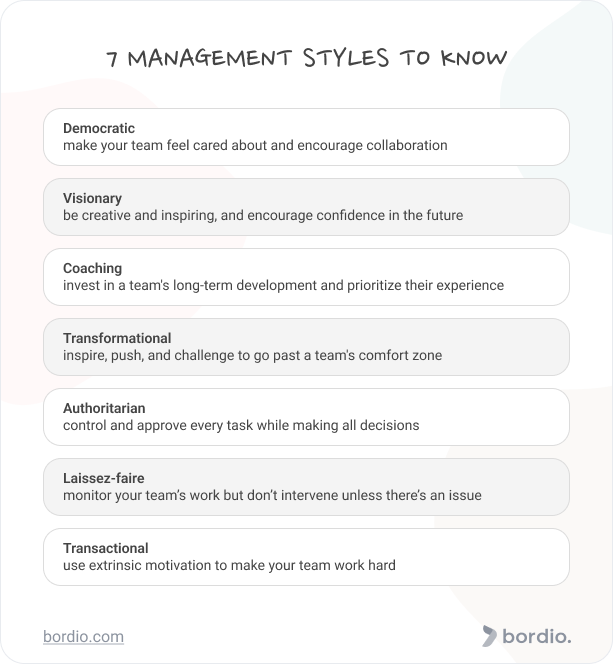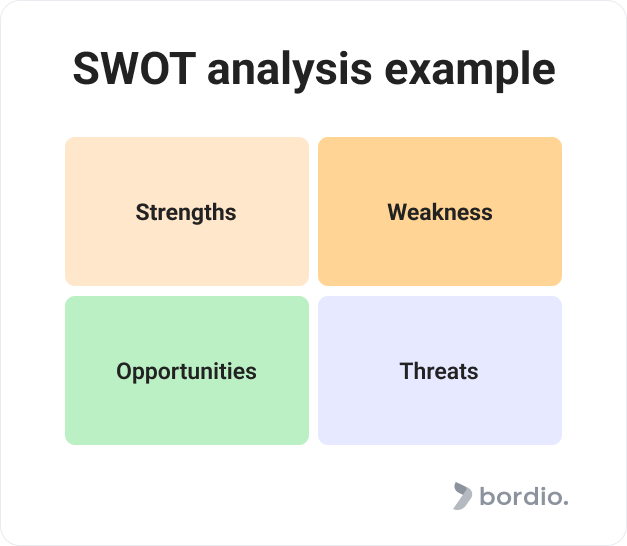Whether you believe that managers are born or they are created, you can benefit from learning about different management styles and techniques.
Being a good manager is a combination of experience, charisma, ability to learn and change. So, if you are someone with 20 years worth of managerial background or a recent college graduate, our management styles guide will give you food for thought and, hopefully, a friendly push to experiment and improve.
What is a management style?
Management style is a way of supervising the team to achieve goals and objectives. The term includes how the manager exercises their authority in both organizing the working process and how they choose to communicate with their subordinates.
Perhaps the main part that a certain management style is characterized by is the attitude that a manager adopts towards their responsibilities and employees.
Management style and leadership style are not necessarily the same but they overlap a lot.
Best management styles out there
Let’s start with the most renowned types of management styles that are praised by countless professionals all over the world.
Democratic management style
Democratic leadership style is also known as participative management style, so you will see those terms used interchangeably occasionally.
The democratic style is all about making your team feel cared about by putting them first. As a manager and a leader, you respect them, their time, and their well-being. And you expect the same in return.
Democratic management styles encourage collaboration and input from everyone on the team. It is great for working with experienced and self-sufficient employees who can organize themselves without being micromanaged. That’s why you will see many democratic managers in Agile and Scrum teams.
Yet when the majority of the team has little to no work experience and deep knowledge of the field, having a democratic environment can create a disastrous mix of poor decisions and failures.
Democratic management style is sometimes compared with consultative management style as they share several resemblances. The consultative management style involves taking team members’ feedback and concerns seriously. The consultative manager often has an open-door policy and consults their employees regarding the processes and ideas, while ultimately remaining the only decision-maker.
Visionary management style
Visionary managers are creative, inspiring, and charismatic. The visionary management style is all about the encouragement of the team and confidence in the brilliant future.
A visionary manager paints a clear goal and a path to achieving this goal. They typically are a great inspiration to the team and help them get inspired to do more and better. However, as the team has its eyes on the prize, the boring, less exciting daily tasks tend to be pushed and ignored. And as we know, the little things that are ignored tend to grow into rather disturbing risks.
Visionary managers must also have strong working ethics or a team of assistants to make sure they don’t fail their projects while having the best ideas in the world.
Tip: if you suspect that you might be prone to missing and ignoring the smaller, less significant tasks in your free task tracker, you will likely benefit from some guidance and a new perspective. Check out our time management books and productivity books lists. Both contain best sellers written by high achievers with renowned vision that will change the way you treat your weekly planner By the way we recommend using an online planner by Bordio and some other top project management tools.
Coaching management style
The coaching management style is all about the individual development of the employees and a long-term approach to team management.
The coaching style is considered very employee-friendly because:
- Their skills and knowledge are put as a priority.
- Short-term failure is tolerated as a hiccup on the way to long-term success.
- Expectations are clearly communicated and supported through goal-setting.
- Career paths are typically clear and there is a transparent system where employees understand what is expected of them to be promoted.
- The company is ready to invest time and money into people’s development, so team members have all the opportunities to become top professionals in the field.
Coaching is an effective management style that supports employees and improves retention within the enterprise. The potential issue with it is that it’s very time-consuming and requires a lot of effort from the managers’ end. Not every team leader will be willing or able to practice the coaching management style, especially if they have their own work to worry about. For better work and project management team can use an advanced task planner for teams.
And just like not every manager will be a good coach, not every team member is willing to be coached. So this style of management, albeit having a strong potential, can be a poor choice for some teams.
Tip: Coaching may be resource-intensive, but it can be optimized with new approaches to learning. There are many ways to learn faster that are used in academia and can be easily adopted in the professional field. And paired with the right online calendar planner that boosts productivity, extra time spent on explaining and mentoring won’t take away from the working routine. Good online schedule planner is online free schedule builder from Bordio.
Transformational management style
A visionary management style emphasizes the attention to the bright future of the company. Coaching management encourages personal growth and is ready to wait longer before seeing the benefits. Transformational style of management can be described as visionary and coaching styles on steroids.
Here, the manager not only sees the bright future for the company and employees but is pushing to get there at high speed and constantly challenging the status quo.
Transformational managers inspire people to push past their comfort zone, grow and dream. Their day planner is packed with strategic sessions, meetings, and reviews of the progress. This style implies leading by example. It means that a manager should also shoot for the stars and be a motivational figure for everyone else.
The risk with this management style is that some people will be unable to keep up with the pace and will quickly burn out. Disrupting the current way of working and doing things differently can definitely lead to innovation, but it is also synonymous with spreading yourself too thin.
Questionable management styles
Let’s be clear here: every management style has its time and place. There are situations where the most praised and popularized way of leading a team won’t work, and the management styles that have been long discounted as wrong will surprisingly lead to the best results.
But it would be incorrect to pretend that some styles of management are just less well-balanced and fitting in the modern workplace. And these are the types that we want to touch on in this section.
Authoritarian management style
Authoritarian or autocratic management style has one of the worst reputations out there.
Authoritarian managers control the entire working process. They see themselves as superior to the team and, therefore, more fit to control and approve every task, as well as make key business decisions on everyone’s behalf. You can meet autocratic managers in conservative project management environments, where frameworks like Waterfall or PRINCE2 are practiced.
The autocratic management style is often criticized because it kills creativity and innovation. Employees quickly see that their initiative, unless completely in line with the managers’ perspective, will not be encouraged or celebrated. That leads to the best-skilled team members leaving for places that will give them the freedom to stand out and have an impact.
Yet authoritarian style allows for quick decision-making as it’s ultimately only one person doing the thinking. So if time is really scarce, for example when you are doing fast-tracking for your project to catch up with deadlines, then an authoritarian management style may be a way to go.
Tip: If you lean towards the authoritative management style but want to soften it up a little, have a look at the persuasive management style. Persuasive managers monitor their employees’ digital to-do lists closely and deliver decisions top-down, but they take the time to help employees understand the logic behind their decision-making process. Such an approach makes it easier to motivate employees as they are given a logical explanation together with instructions.
Laissez-faire management style
Laissez-faire is a French term that translates as ‘leave alone.’
It is a hands-off approach that gives employees absolute freedom to work on their goals and achieve their targets without managers’ involvement or approval.
The Laissez-faire management style is rather extravagant because it implies that managers trust their team members 100% and that the team themselves possess all the necessary knowledge and skills to deliver the best results.
The critics of the method joke that it’s a perfect management style for leaders who just want to get their paycheck and not bother about actually doing the work. And there is some truth to that because if laissez-faire managers are not involved in their team’s work process, then what exactly are they doing? It will be convenient to keep track of this if you use team tracking software.
But probably an even bigger risk hides in the results that we can expect from the team. How can we guarantee that they will be at least satisfactory, if not excellent? Hiring top-skilled employees can minimize the risks here but it is an expensive route. Plus, the results also have to be compliant with the company’s big vision and goals, in addition to being just good.
Despite the criticism, the laissez-faire style can be a life-saver for companies that want to disrupt the market but are unsure how to do it yet. This can be done by startup marketing agencies so you will not have to think about the tasks associated with market research.
A good laissez-faire manager will monitor their employees but not intervene unless they see a potential issue or challenge. The team, on the other side, works independently but knows that they can reach out to the manager should they need advice or help. Work can be controlled remotely using tools such as free virtual planner and simple task maker.
Transactional management style
The transactional management style thrives on extrinsic motivation, such as commission and stock options. Intrinsic motivation would be a desire to succeed and grow within the industry, or to make a product that will bring value to people.
Such a style of management has limitations from both ends. It can teach employees who were initially motivated intrinsically to look for extrinsic motivation and only work hard then. Those team members who are always after things like stock options will only deepen their behavioral patterns, looking for more and more immediate rewards, and procrastinating if a task they’re assigned does not come with a commission bonus.
That’s not to say that extrinsic motivation is inherently evil. People do, after all, come to work and give their time in exchange for a salary. But it must be used in combination with other factors if you’d like to have a team who is passionate and eager to reach goals and targets. Transactional managers though are often not motivated to change their ways either. As a result, we get a mediocre team that is deemed to deliver okay-ish results and never really grow to its full potential.
Why is it important to work on your personal management style?
It’s very common for people to be promoted to leading positions without any managerial experience. It happens because someone might have exceptional knowledge of the industry or a long history with the company.
When such accidental managers start working, things can go downhill pretty quickly because they just have no idea what they’re doing. The most common consequences of those situations (given that the new manager is not a natural and makes mistakes along the way) are:
- The company bears the consequences of poor management decisions leading to financial loss and, possibly, a market share loss.
- Employees see that their manager is not up for the job, get frustrated, and leave.
- The HR reputation suffers because ex-employees and company partners share their concerns, so new candidates become wary of accepting the job offer or applying altogether.
- The said manager experiences stress as they are under constant pressure.
A good manager inspires the team, a poor one creates a demotivated, non-creative environment with disengaged employees. Poor management is one of the top reasons why people quit their jobs and losing people is a huge burden for any company.
A wrong management style that doesn’t fit with the corporate culture and circumstances will be detrimental to the company’s success. Continuous improvement of your managerial style will make your team’s performance better and your career prospects brighter.
Tips for improving your management style
Developing strong leadership skills and finding the right management style requires time, effort, and patience. Everyone’s journey will be unique but there are universal tips that can boost one’s professional growth and employee engagement.
#1 Be self-aware
It’s easy to spot what others are wrong about, but very hard to notice similar patterns in yourself. Practice self-awareness where you pay more attention to your reactions, subconscious or not, and compare them against the blueprint ways of responding.
Self-awareness is one of the key emotional intelligence elements that any professional, especially a manager, needs to possess.
#2 Evaluate yourself as a manager
You can use techniques like SWOT analysis for self-evaluation and, if you are brave enough, you can even ask your team members to submit their SWOT reviews on you anonymously. With the results in front of you, you will be able to see what needs your immediate attention.
There are many ways you can make employees feel valued, and showing them that you are working on yourself is one of them.
#3 Get a mentor
Find someone who can consult and guide you in your management process. It would be great to find a mentor outside of your employment to avoid bias. If you have to choose someone from your organization, make sure this person is not involved (even indirectly) in similar processes and tasks as you.
If a mentor or a coach is out of the question for you at the moment, look for inspiring leaders and managers who you admire. Find their interviews, books, and articles to soak up their wisdom through.
#4 Utilize technology
Good software will help you manage your projects and teams better. A smart project management solution will automate and streamline a lot of the processes and become the assistant you’ve long been looking for.
Bordio, for example, has a smart workload tool that enables anyone to see how much work they are doing and balance their tasks effectively without constant supervision. Functionality like time blocking will help ensure team members have enough capacity and plan for work in advance, so no deadlines will be missed.
#5 Make it yours
Whatever management style you end up going with, make sure it aligns with the following three:
- Your personality and skill set.
- Your team’s culture and experience.
- Your company’s values and positioning.
As you move from one company (or team) to the other, don’t forget to look back at your previous experience with management and consider if any alterations would be helpful for your next project or position. Management, after all, is not a science, so don’t be afraid to change something up if it feels right.
How to choose your management style as a first-time manager?
The first thing you need to remember about management styles is that they can be combined. You can mix and match and see how that works out for you.
For example, if you are drawn towards an authoritative style but are afraid to scare people off, remember that you can choose to control but not micromanage. Or you can keep the autocratic style for key business decisions where stakes are high and you possess the most experience or knowledge, but engage employees in problem-solving for lower-tier decisions.
Also, be careful with the management styles that are considered safe and good. For example, if you are an inexperienced project manager, using a democratic or collaborative management style can backfire. Employees might make wrong decisions that you won’t be able to foresee, or they start working less efficiently because you are keeping it positive and don’t practice strict management oversight.
In general, it is smart to not follow one or the other leadership style 100% but make it work for your specific case, and personality. Don’t take the extremes – it can hurt you, especially when there’s little experience and theoretical knowledge of the nuances of management styles.
Bonus tip: If you are starting as a manager in a new team or have recently been promoted to manager in your company, having a plan for the first three months will help you navigate the new role with grace and the best results. We have prepared a guide on the 30 60 90 Day Plan that outlines the key steps all new managers and leaders need to take. Make sure to check it out, and good luck!










